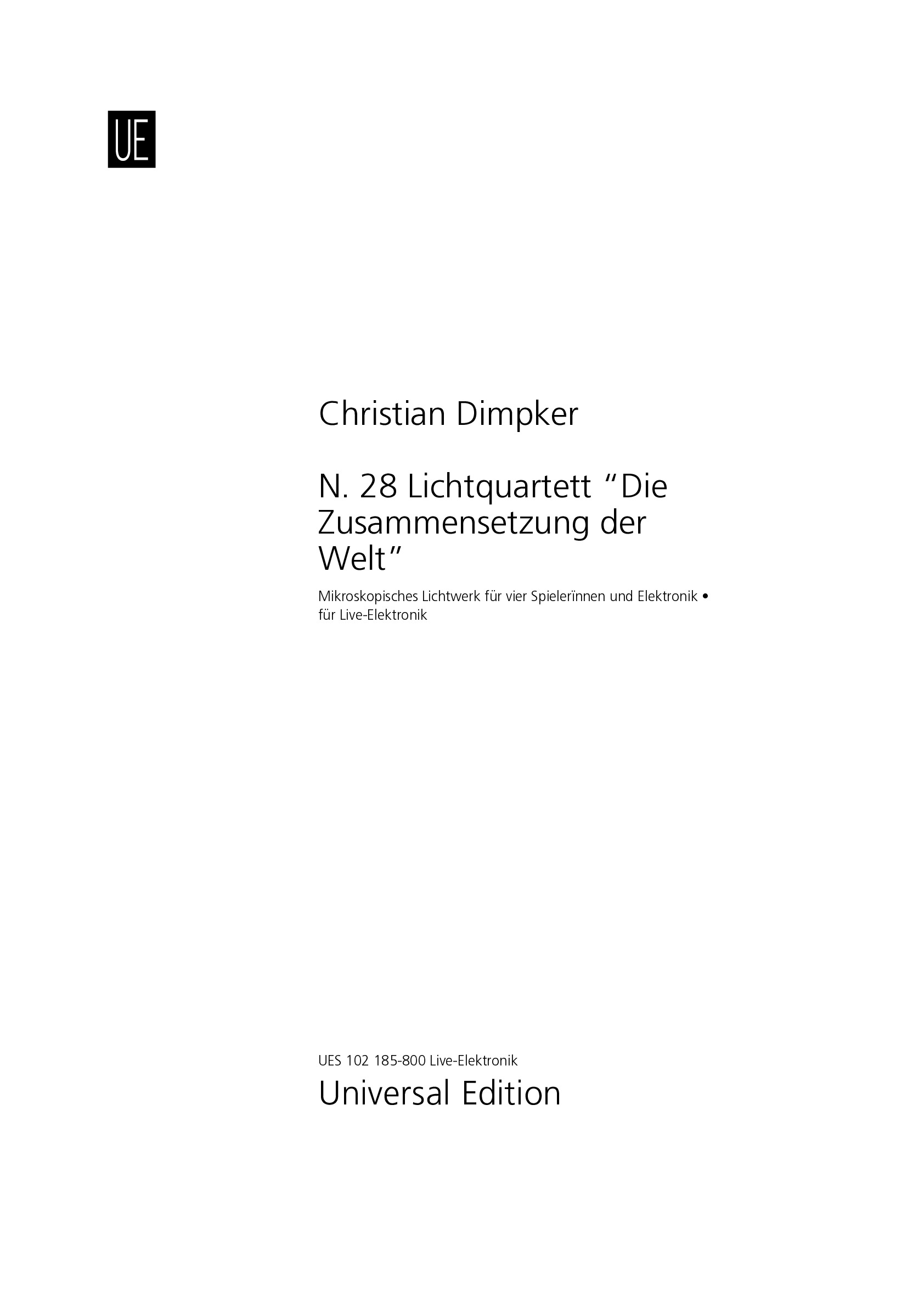

Christian Dimpker
N. 28 Light quartet “Die Zusammensetzung der Welt”
Duration: 11'
Solos:
live electronics
N. 28 Light quartet “Die Zusammensetzung der Welt”
Translation, reprints and more

Christian Dimpker
N. 28 Lichtquartett “Die Zusammensetzung der Welt”Type: Noten
Sample pages
Video
Work introduction
The light quartet Die Zusammensetzung der Welt penetrates into the depths of our existence – which is a realm of incredible beauty. And be aware: the further you dig, the more of that beauty reveals itself. The work explores this depth by means of prepared light microscopes, which uncover samples of various inorganic and organic substances and send their discoveries to TVs and projectors, while the viewers themselves become a screen and immerse themselves in the work. The sound increasingly delves into the background, but at the same time also into the substance of the world. The listener sinks into the depths of the ocean, climbs up to the heights of winds, listens to animated soil and burns in a roaring fire. In addition, the actions of the players are inspected by means of contact microphones. However, the focus is on the visual level, which – like all sounds – completely ascends from the art of the notation and thus can be perceived in two ways. During the performance, however, the players do not work with the score. They receive their instructions from the conductors and the light tubes underneath the table, which emit polarised as well as unpolarised light of various kinds and enables them to access the samples in always different manners.
What is necessary to perform this work?
The set up is presented on pp. VI f. The piece is for four players (any trained instrumentalist / singer). Two of the players act as conductors. The four players also undertake the realisation of the electronics if no sound director can be brought in. The light should be programmed, but can also be controlled by a lighting director. The players are exposed to a reaction game. They react to lights and the instructions of the conductors. The top image on p. V shows the view of the audience, meaning that the spectators look into the projector and become part of the piece themselves. They can put on sunglasses if the light dazzles them too much. If there are ranks in the hall, some parts of the audience may also watch the piece outside of the projections. In this case, larger TVs / projection screens should be chosen and positioned next to the tables. Player 1 is situated to the left behind the table (from this point of view), player 2 to the right behind the table and the conductors diagonally in front of the table, maybe elevated (in order not to stand in front of the screens / projector). Construction: Three microscopes each with three lenses of the highest possible resolution and an analyser for polarised light are required. A camera is attached to each microscope, which – as shown – is sent directly to the TVs or the projector. The microscopes are light microscopes with coarse and fine adjustment wheels. However, the light is not attached to the microscope itself, but comes from the tubes located under the glass table. In order for this to work, the respective microscope must stand on a base, which allows the light from under the table to reach the lenses. Aside the microscopes 1/3, two trays with 15 samples each are placed. They are selected by the players according to their visual-aesthetic perception and brought into an order that is meaningful for them. The only condition is that they choose anisotropic materials, while the main idea is to show the beauty hidden in the depths of this world. The materials should be distributed over a large area so that the microscope stage does not always have to be adjusted when changing specimens. Moreover, the tubes direct the light. They may be equipped with reflective material (e. g. aluminium) inside and extend directly to the glass of the table. If the light intensity is insufficient, additional lenses may be used. At least the tubes C, D, E, F, G, A, B of player 1 should all carry different light sources. Ideally, all twelve light sources are different. Coloured light can also be used. The tubes of player 2 copy this structure, while the light tubes in the middle are constructed like the sidewise light tubes of the same pitch. The light source C occurs twice, but should be coloured differently. The light sources C, D, E, F, G, A, B of the chromatic tubes and the two squares C, D, G, A of the diatonic tubes are additionally equipped with (freely selectable) polarising filters. The lights can be switched on and off, but they can also be varied in their intensity. Alternatively, the tubes can be installed side by side on the table and a microscope mirror be used to direct the light. Actions: at the beginning of the piece, all microscopes are situated outside the light fields. During the performance, the players do not use the score, but they can take notes during the rehearsals. They respond to the light and the directions of the conductors. Whenever a light is turned on, they slide their microscope over it. When more than one light is on, they spontaneously decide which light they push the microscope over. When all the lights are turned on, the lens is changed. If all lights are turned off for a longer duration, they change the sample. The centre microscope is operated by both players. Here the light also determines which player takes it. Both need to be able to access it easily. The conductors give instructions on the operation of the coarse / fine adjustment (see p. VI). They can see the TVs and the audience screen. Sonic component: the two contact microphones (broad frequency response) send – as indicated – to one speaker at a time. They clearly amplify the sounds created by the players moving the microscopes back and forth (possibly with strongly increased dynamic level and freed from background noise). The players need to take care of the the motions of the microscopes producing pleasant sounds (for them). They may prepare the bases accordingly (e. g. with felt) or equip them with wheels. In addition, they are modified by a convolution reverb (big mosque, ca. 5.3 sec, 0 ms pre-delay). In addition, four stereo recordings are produced, each with two contact microphones / hydrophones / geophones / microphones (ad libitum): A. Go on a boat trip in the ocean, stop the engine and let the microphones down into the water, using a long cable. Wait as long as possible and then bring them up again. If the material is dense, use an excerpt. Otherwise, compress the material (without changing the pitch). B. Light a fire, place coal (or similar material) on top of this pile and attach two microphones to two of the top pieces. Wait until the microphones break. If the microphones break too quickly, the material can also be stretched by copying longer passages. C. Place microphones in an ant hill and record the movements for the duration of the piece. D. Attach two microphones with a long cable to a kite and let it rise. Record the action for the duration of the piece. If the weight of the microphones is too high, this recording can also be simulated (by shaking the kite irregularly). All recordings are transformed as indicated in the score and by the following effects. Recording A: 1. flanging-effect (13 ms, 75 % feedback, 4 Hz sine-LFO 70/30 % dry/wet ratio), 2. stereo delay (100 ms delay medium wide left, 150 ms delay medium wide right, both 55 % feedback), 3. convolution reverb (big church, ca. 2.5 sec., 0 ms pre-delay). Recording B: 1. distortion (field effect transistor, 18 dB), 2. chorus (10 ms, 15 Hz sine-LFO, 50 % feedback, 75/25 % dry/wet ratio), 3. convolution reverb (concert hall, ca. 1.8 sec., 6 ms pre-delay). Recording C: 1. EQ (low shel f with 30 Hz cut-off frequency, – 12 dB gain, Q = 0, ordinal number n = 3; parametric with 320 Hz cut-off frequency, 8 dB gain, 250 Hz bandwidth, ordinal number n = 2; parametric with 1 kHz cut-off frequency, – 10 dB gain, 400 Hz bandwidth, ordinal number n = 2; high shelf with 6 kHz cut-off frequency, 8 dB Gain, Q = 5, ordinal number n = 3), 2. stereo delay (32 ms delay wide left, 48 ms delay wide right, both 55 % feedback). Recording D: 1. pitch shift (linear predictive coding, – 1 octave), 2. ring modulator (293.6 Hz / D4), 3. flanging-effect (delay: 7 ms, feedback 70 %, no LFO) 4. delay (38/52 ms, feedback: 80 %) and the contact microphones in the hall by means of a convolution reverb (big church, about 2.5 sec, 0 ms pre-delay). Further modifications are depicted in the score (for details see p. VII). Installation: The piece can also be installed. For this purpose, however, each light tube must be picked up by a microscope and sent to a TV distributed in the room (side) or a projector (centre). In total, 24 televisions, 16 projectors and 40 microscopes are needed. The lenses are randomly picked and sometimes focused, sometimes not. Light and sound are played back automatically. The exact set up of this work is determined by an interpreter. The televisions are distributed throughout the room and the images of the projectors superimposed on the walls. The samples are distributed to all microscopes. Additionally, 12 contact microphones under plates made of different materials distributed in the room are used to pick up the treading noises of the audience. Digital version: It is also possible to record the elements of the piece individually and provide them together with the sound recording in such a way that the piece can be installed in a gallery. The work will be recorded at 30 fps. To compensate for the lack of performativity, the gaps in the preparation changes are interrupted by always different, randomly selected fragments (with a duration of 1-5 frames) taken from the other two microscopes and, respectively, from all three microscopes for the projector. Here, darkness is mixed with flickering, freely manipulated (inversion, reflection, noise, solarisation, etc.) microscope images. The original sequence (O) created in this way may then be used again in retrograde (R), inversion (I), retrograde inversion (RI) and additionally be blended with another sequence. It may be cut or played faster / slower to fit into all the gaps. Two sequences each – O1 to O4 – and three derivatives per sequence – R1 to R4, I1 to I4 and RI1 to RI4 - are created for light I & IV (see p. VIII). The piece must be performed / exhibited in complete darkness in an acoustically separated room.
